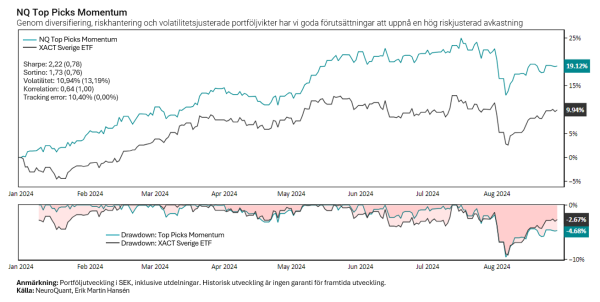Update Top Picks Momentum

Top Picks Momentum buys and sells stocks based on our Pure Momentum strategy. This strategy identifies low-volatility uptrends, with the assumption that these trends often last longer than expected.
While momentum strategies do not always perform optimally every year, our studies show that volatility-adjusted momentum, combined with risk-adjusted portfolio weights, has historically outperformed indices over longer periods of time.
The holdings in the portfolio are based on momentum rankings from the Pure Momentum page in our platform. The strategy also allows for discretionary decisions, which means we have the option to exclude certain stocks.
Development since the last update
Since the last update on August 8, 2024, the portfolio has increased by 2.7%, which can be compared to the Stockholm Stock Exchange which has risen by 4.9%.
- The biggest positive contributors have been Ambea (+0.62%), Raysearch Resources (+0.56%) and Lundin Gold (+0.55%)
- The biggest declines in the portfolio have been Wästbygg Gruppen (-0.93%), Precise Biometrics (-0.35%) and Projektengagemang (-0.20%).
Development Year to Date
Changes
Due to lower momentum ratings than 50, we have sold some holdings.
Login required to see changes in model portfolios
Not a customer? Open an account to access our analytics service.
We have also sold some holdings that have fallen too far down the rankings even though the momentum score is above 50. To avoid companies that perform worse remaining in the portfolio and taking up space for stronger stocks, we can, for example, use a limit where the portfolio holding must belong to the top 20% of the universe in order to remain in the portfolio.
With the cash released after the sales and rebalancing, we have brought in some new ones.
Market filter removed
We have implemented a change in our strategy for Top Picks. Previously, we used a market filter/trend filter that meant that the strategy stopped new purchases when the Stockholm Stock Exchange's broad index traded below the 200-day moving average. This meant that the portfolio built up cash during longer market declines by selling stocks with weak momentum while refraining from making new purchases.
This market filter has previously only been applied to Top Picks Momentum and not to any of the other two equity strategies, Value & Momentum and Volatility & Quality.
Top Picks Momentum, which is based on the Pure Momentum strategy, will continue to have capital protection built in. The strategy only buys stocks with a Momentum score above 50, and during weaker market periods the number of companies meeting this criterion decreases, which in itself limits exposure.
The information document shows backtests on a few different variants of Pure Momentum.
Click here to read more about Pure Momentum (PDF document).
Holding
Login required to view holdings in our model portfolios
Not a customer? Open an account to access our analytics service.
Frequently Asked Questions (FAQ)
Frequently Asked Questions Where can I find the holdings and portfolio weights?
You can find our holdings and weights on the Model Portfolios page. You can also filter the model portfolios via the watchlists on several pages in the platform.
Can I export portfolios to Excel?
On the Model Portfolios page, you can export to Excel. Select a portfolio and then click the download icon at the top right of the page. When I export holdings and weights, I don't get the weights to 100%. The weights are rarely exactly 100% because we buy stocks from the rankings until the money runs out. The weights we rebalance to are the target weights that are displayed in the platform on the day the rebalance occurs. Keep in mind that these target weights may look different after a couple of weeks as volatility and share prices have changed. The target weights in the platform are updated every day.
How often are the portfolios updated?
Our model portfolios are updated approximately once a month. The frequency is a trade-off between several factors, such as transaction costs and administration, which are weighed against the benefit of frequently resetting risk. For the model portfolios we offer today, rebalancing once a month works well. If a stock falls by 20%, this means a decline in the portfolio by 1% if we have 20 stocks in the portfolio with a 5% weighting in each. Major price drops are not a disaster unless we have very concentrated portfolios.
Do I have to rebalance the position if the target weight does not deviate significantly?
We rebalance to restore the risk we have allocated. We allocate 10 bps (0.10%) to each holding. During a “normal” day, the holding should affect the portfolio by 0.1%. If the target weights do not deviate significantly from your current position size, you save time and transaction costs by not rebalancing.
What do volatility-adjusted portfolio weights mean?
We want to treat all companies in the portfolio equally, that is, all companies should have the same theoretical chance of affecting the portfolio. We do this by adjusting the weight of the holdings according to the volatility of the stock. A stock that fluctuates a lot will therefore have a lower weight in the portfolio. If we were to weight all holdings equally, the most volatile stocks would characterize the development of the portfolio, and this is not optimal unless the holdings have the same volatility. This method also leads to us reducing the position size in holdings that are starting to fall, since declines often covary with increased volatility.
How many stocks are in the portfolios?
The number of stocks in the portfolios varies between about 20 and 30 holdings. We use a method where the number of stocks is just right to achieve the effects of diversification. If we have fewer than 20 companies, the company risk starts to increase for individual holdings. High company risk is something we want to avoid because we are agnostic and do not “bet” on individual companies.
Do you use stop loss?
No, we do not use stop losses in the model portfolios. If a holding falls out of the ranking during monthly rebalancing, the stock is sold. But there are no stop losses. For shorter strategies such as swing trading, we recommend stop losses. This means that before entry, you determine a level at which you will sell if the position goes against you, either directly in the software or by recording the level.
Should you track all stock portfolios?
No, you don't have to. The important thing is that you have time to manage the portfolios, even during weaker periods when it is more tedious to log in to the account. We currently have three stock portfolios. This can change. Over time, the stock portfolios have a high correlation with the stock market. After all, we buy stocks. Follow the concept that you believe in. Learn to make your own decisions. If you don't strongly believe in the concept, you won't follow the strategy during weaker periods. The best strategy is the strategy we can maintain over time.



